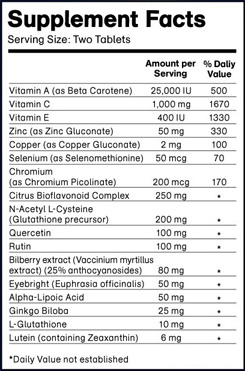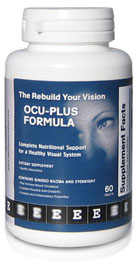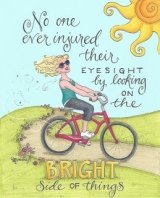Visible Light and
UVAffect Your Eyes Wear Sunglasses and a Hat Whenever You're Outside
| |
|
|
|
|
 |
|
 |
Visible light and UV affect your eyes due to the radiation striking the lens and retina.
As discussed in Eye Diseases ultraviolet ( UV
) light increases the risk of developing cataracts, and visible light (especially blue) light increases the risk of macular degeneration.
To give you 100% protection from both ultraviolet and visible light and how uv affects your eyes, the resulting sunglass lenses would be almost black, and you would be able to see almost nothing.
So you’ll have to aim for a balance between protection and usefulness.
This balance may mean you’ll have to purchase a few pairs of sunglasses to protect you from both ultraviolet and visible light and uv affect your eyes.
If you spend a lot of time at the beach or on the water, you’ll need maximum blue light protection along with glare reduction and 100% UV
protection.
If you drive a lot, you’ll need sunglasses that give 100% UV
protection and allow in enough visible light and uv affect your eyes that you can see traffic lights and signs.
Here is a checklist to help you buy the best sunglasses for your ultraviolet and visible light and uv affect your eyes protection needs.
This checklist is adapted from See Again! a Macular Degeneration Book by Alexander M. Eaton, M.D.
UV
Protection
There are over 300 commonly prescribed medications that have been shown to speed up Cataract formation when the eyes are exposed to sunlight.
So it's even more important to cover your eyes if you're on medication.
Any pair of sunglasses you purchase should give you 100% UV
protection, the major culprit in cataract formation.
Ensure that the label indicates the precise level of protection, not just that the lenses meet ANSI
standards.
Lens Darkness
The darker the lenses, the better the protection from blue light, which can lead to Macular Degeneration.
Test Sunglasses by wearing them outside on a bright, sunny day. The glasses should give you comfortable relief from brightness and glare, while letting in enough light to see traffic lights.
The goal is a pair that lets in 12 percent or less of visible light and uv affect your eyes.
If you can see your eyes while looking in a mirror while wearing the sunglasses, they let in too much light.
But less than seven percent can be a problem if you drive, as you won’t be able to see traffic lights soon enough.
Blue light transmission through your sunglasses should be about two to five percent.
Less than this will leave you seeing distorted colors.
Lens Color
Your choices are orange/amber, brown or tan, gray or green, yellow, and blue/purple.
You will find brown or tan lenses the best for protecting your sight from both ultraviolet and visible light and uv affect your eyes damage, but I offer a description of each type of lens so you can make an informed decision.
Please remember that these descriptions are based on you buying good quality sunglasses, ones where 100% UV protection is a given.
Orange and amber lenses block 100% of blue light, which causes blue objects to appear black, and white to appear orange.
This aspect of “blue-blocking” sunglasses makes them intolerable for many people.
Brown or tan lenses block almost all the blue light, usually over 95% of these short wavelengths, but not all of it.
Thus, they do not distort colors.
Gray or green lenses also provide protection, but not as much as the brown and tan ones.
Because gray lenses let in the same amount of all light wavelengths, there are no color distortions with them.
Yellow lenses increase contrast on cloudy days, but since they let up to 80% of the light to pass through, they don’t offer enough protection on sunny days.
Blue and purple lenses are more likely fashion lenses for indoor use.
Don’t use them as sunglasses as these lenses will not block blue light from entering your eyes.
Polarization
Polarized lenses allow only light from certain angles to pass through to your eyes.
Thus, they reduce glare from lakes and seas, and reduce it from the windows of vehicles around you while you’re driving.
Transitional Lenses
These lenses, also known as photochromic lenses, automatically darken when exposed to sunlight.
The amount of darkening depends on the temperature and on the amount of sunlight.
You can find photochromic sunglasses with either glass or plastic lenses.
Glass lenses work better than the plastic ones, and they’ll work inside your car.
Plastic photochromic lenses require exposure to direct sunlight, so they won’t work well when you’re driving.
These lenses work better in colder temperatures because the degree of darkening is lower with higher temperatures, and it takes longer to darken when it’s hot.
 |
|
 |
|
|
 |
|
|
Gradient Lenses
These lenses offer you varying degrees of darkness from top to bottom.
Most gradient lens sunglasses are darker on the top (where it’s most needed for protection from ultraviolet and visible light and uv affect your eyes) and lighter on the bottom, which makes reading and “line-of-sight” viewing easier.
A variation is lenses with dark tops and bottoms, with a lighter section in the middle.
Lens Shape
You can choose between flat and curved sunglass lenses.
Curved ones are the most common and provide clearer visible light and uv affect your eyes and the best protection from both ultraviolet and visible light.
Coatings
There are several types of coatings, including mirrored coatings, anti reflective ones, scratch-resistance coatings, and UV protection coatings.
Mirrored coatings are thin layers of metallic paint.
They don’t change the amount of transmitted light through the lens by very much, and are mostly a cosmetic coating.
They can reduce glare in bright environments such as snow, ice and bodies of water.
Anti reflective coatings on sunglasses are becoming common, and are used to reduce glare.
They are also used to reduce reflections on the inside (back) of the lenses.
As with vision correction glasses, these coatings make it more difficult to clean the lenses.
Scratch-resistance coatings are necessary if you have sunglasses with plastic lenses.
These lenses are made with CR39, polycarbonate or acrylic plastics.
Polycarbonate lenses are virtually shatter-proof, but scratch easily.
CR39 is also shatter-resistant.
UV
coatings are added by dipping the lenses into hot PABA, the sunscreen ingredient.
Frame and Lens Size
What size frame is right for you?
One that does not let in much light from any angle except through the lens.
Test this by taking the sunglasses outside and moving your head up and down and side to side.
If you aren’t allowed to take them outside, test for stray light by looking at a bright bulb or spotlight.
Find the largest sunglasses that don’t touch your eyebrows or cheeks, as contact will soon bother you.
Also important is the distance from the lenses to your eyes.
This, along with the frame size, determines the amount of light that reaches your eyes.
Dr. Eaton in See Again! writes that if you increase the distance of the lenses from your eyes by just one-quarter of an inch (6.5 mm), you increase the amount of light reaching the eyes by ten to twenty times.
Wraparound lenses offer the best protection.
These sunglasses sit close to your eyes, and have lenses that follow the curve of your head, thus reducing the amount of stray light reaching your eyes.
If you’re like me and handle your glasses roughly, thick plastic or nylon frames will last longer than wire frames.
Expandable hinges in the arms will reduce breakage.
Clip-ons and Prescription Sunglasses
If you wear Prescription Glasses, you have two choices: purchase clip-ons or a pair of prescription sunglasses.
Clip-ons slide onto your lenses from the top or from the outside edge of each lens.
In either case, sooner or later they will scratch your prescription lenses, which may affect your vision.
If you like to wear clip-ons, try glass lenses, which are less prone to scratching.
A new type of clip-on, which I use, fastens to the glasses by way of magnets set into the frames.
With these clip-ons, there is no scratching as they don’t touch the lenses. These clip-ons usually come with the glasses as a package deal.
As with regular sunglasses, ensure that you are getting 100% UV
protection and 88-95% visible light and uv affect your eyes protection.
Many cheaper models don’t offer good UV
protection.
If you want to purchase a pair of prescription sunglasses, the coloring of the lenses will differ from that of regular sunglasses.
Corrective lenses are usually dipped in a tint.
Lenses for Myopia (nearsightedness) are thinner in the middle and thicker at the edges.
This makes the center lighter in tint color than the edges.
If you are farsighted Hyperopia, the lens is thicker in the middle, and thus will be darker than the edges.
Optical Quality
As discussed the Amsler Grid is a diagnostic tool used to determine if someone has the wet form of macular degeneration.
This grid can also be used to test the optical quality of the sunglasses you’re considering buying.
You do this by holding the glasses about six inches from one eye while closing the other eye.
While holding the Amsler Grid at arm’s length and in good visible light and uv affect your eyes, move the glasses around the grid while focusing on the dot in the center of the grid.
Look at the center and at all the edges of the lenses.
The lines will all remain straight with a good pair of sunglasses.
Poor quality lenses will show you lines that appear distorted. This distortion appears as bent, curved, swaying or moving lines.
If you forget to take your Amsler Grid with you, use a light post, utility pole or doorway that has a straight vertical line. The same distortion effects will appear.
Cost
As with anything else in life, you get what you pay for.
More expensive sunglasses usually give you better protection from ultraviolet and visible light and uv affect your eyes, longer-lasting frames, the best optical quality, and a warranty.
They usually come with more information about their levels of eye protection as well, so you can make a more informed decision.
However, if you have a habit of losing or breaking sunglasses, you won’t want to spend hundreds of dollars on the best sunglasses.
Before you snub your nose at the expensive ones, though, check to see if there is a breakage warranty, which may help if you’re hard on your eyewear.
Labelling
Currently, labeling of sunglasses is not very concise, nor is it very helpful.
The American National Standards Institute ( ANSI
) standard uses only three categories:
- Cosmetic
- General Purpose
- Special Purpose
Visible light and uv affect your eyes transmission ranges from 40-100% for Cosmetic, 8-40% for General Purpose, and 3-8% for Special Purpose lenses.
(Special Purpose lenses can’t be used for driving as they don’t allow a minimum of eight percent red light, and a minimum of six percent green and yellow light, to pass through.)
The European Community standard, CE, has slightly better labeling, but it still isn’t precise enough to know exactly the protection you’re getting for visible light and uv affect your eyes.
The CE categories are 0 (80-100% visible light and uv affect your eyes transmission) for cosmetic use, 1 (43-80%) for cosmetic use, 2 (18-43%) for light-tint sunglasses, 3 (8-18%) for regular sunglasses, and 4 (3-8%) for special purpose dark sunglasses (which can’t be used for driving).
If the sunglasses meet the ANSI
Special Purpose standard or CE level 4, they will give you excellent protection as long as they block 100% of UV light, but you won’t be able to drive with them.
If you want a pair that falls into the 12% range of visible light and uv affect your eyes transmission, you’ll have to accept the CE level 3 along with 100% UV
protection, even though this range goes to 18%.
Wear a Hat
Don’t forget to wear a hat.
If you wear a hat with a visor, and use it with the visor over your visible light and uv affect your eyes, you’ll reduce the amount of ultraviolet and visible light and uv affect your eyes by up to 50%.
So a $10 hat could reduce the amount you have to pay for sunglasses.

Subscribe to EyeSight Vision Care! , our monthly newsletter with in depth information to help you keep up to date on how to Protect Your Eyesight with a free bonus. Fill out the form below. You'll then receive an email asking you to confirm that you subscribed. You'll always have the option to unsubscribe at the click of your mouse.



